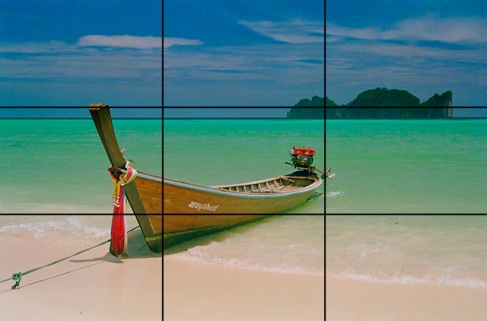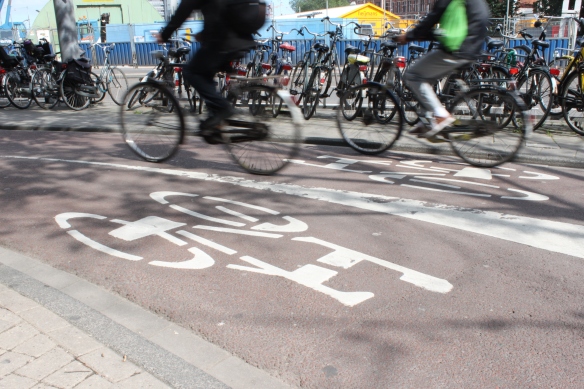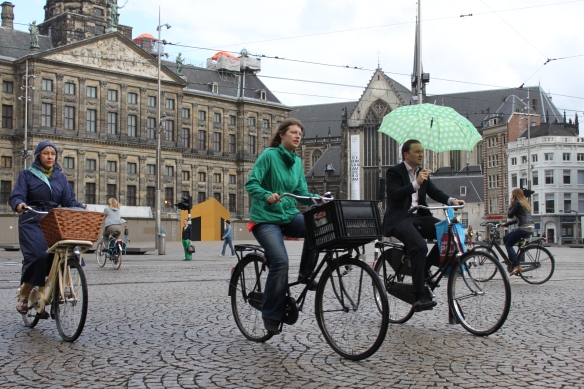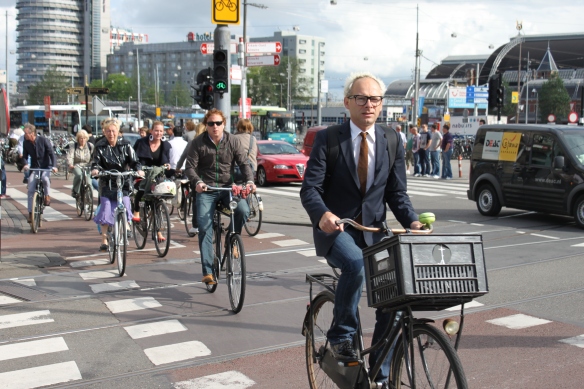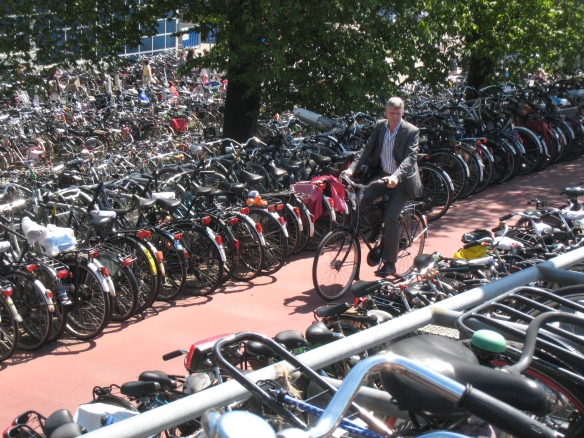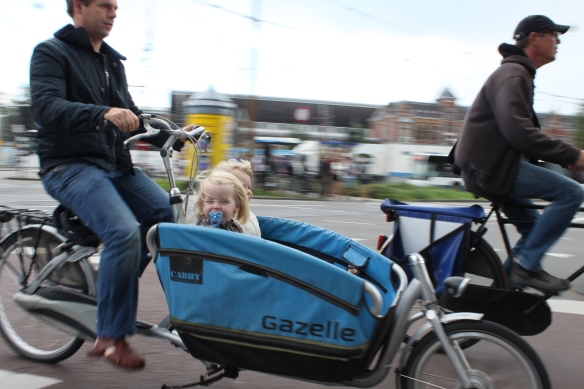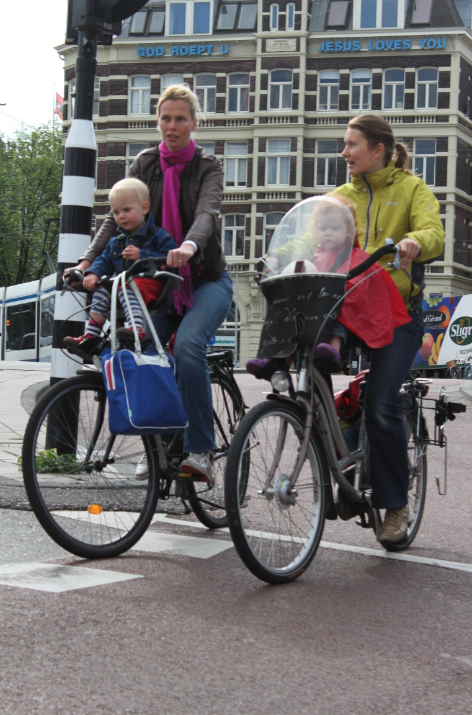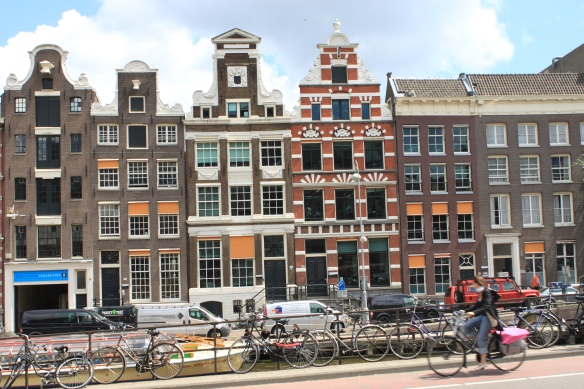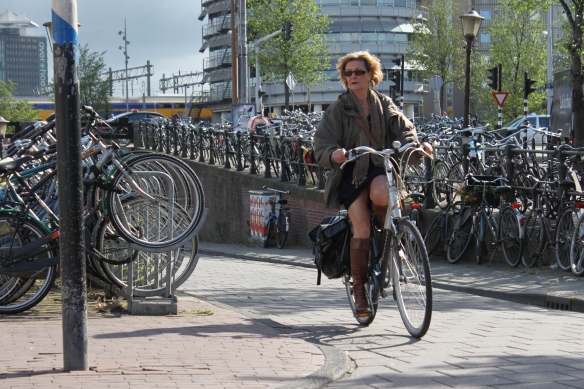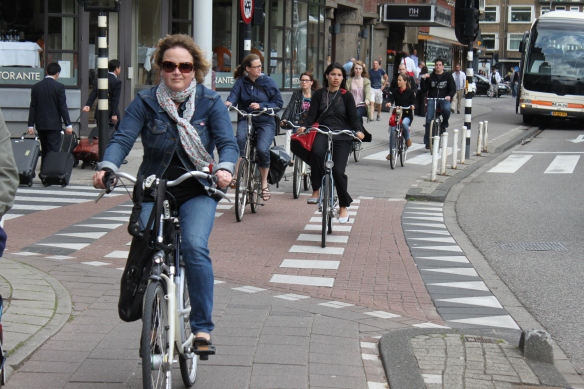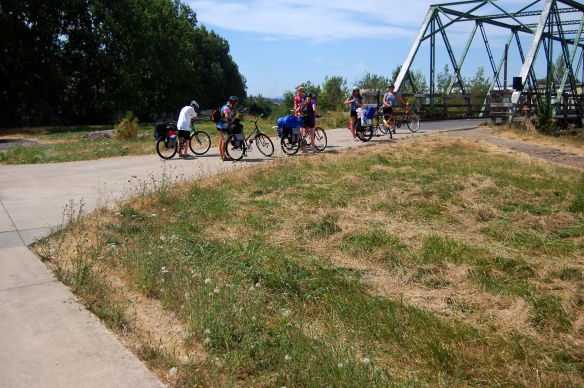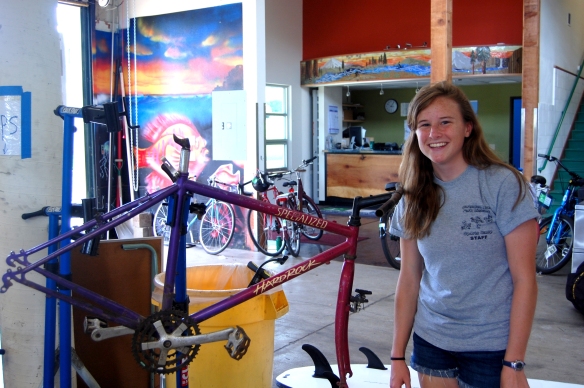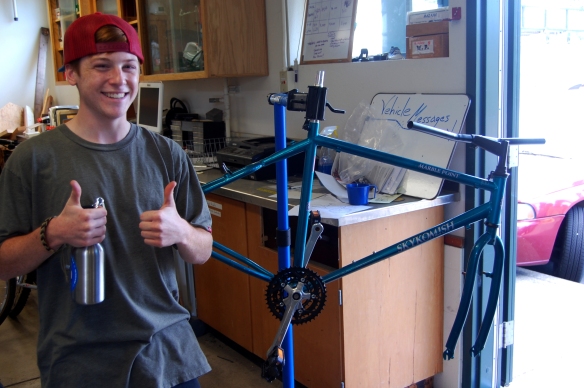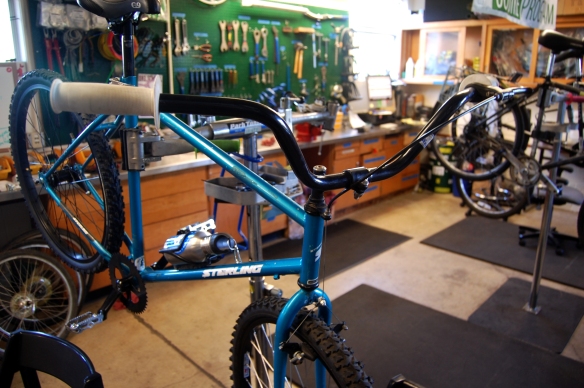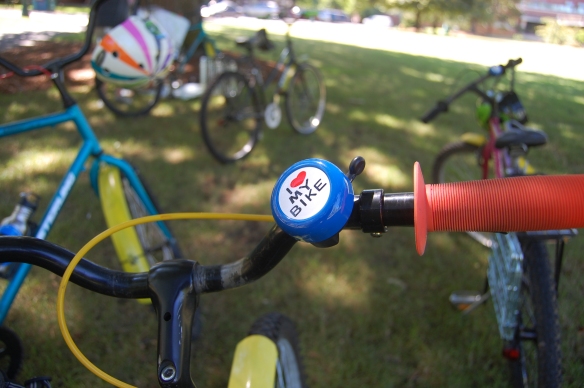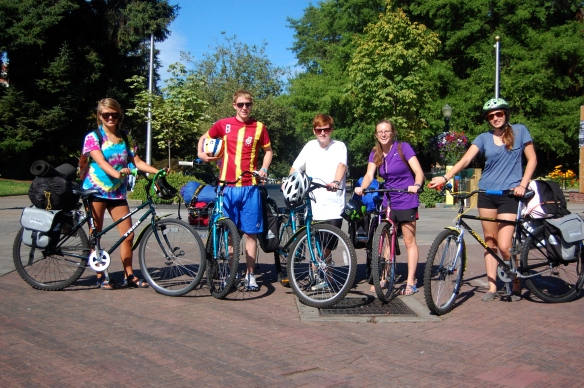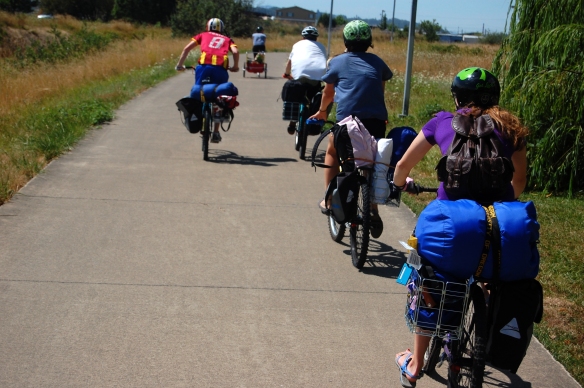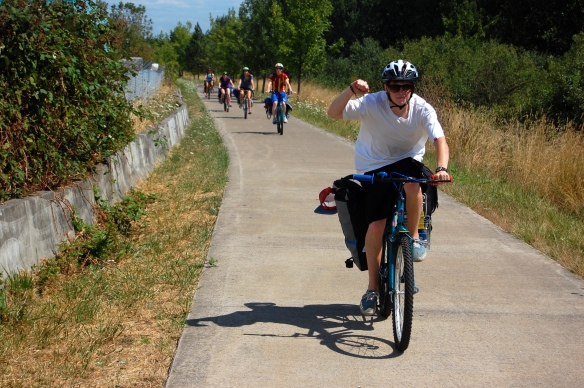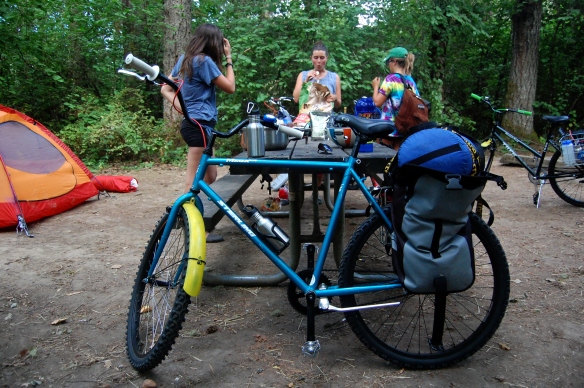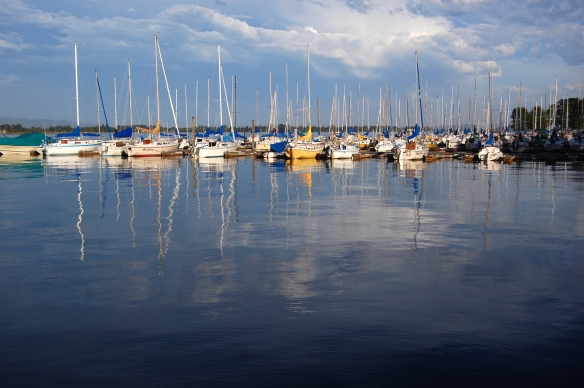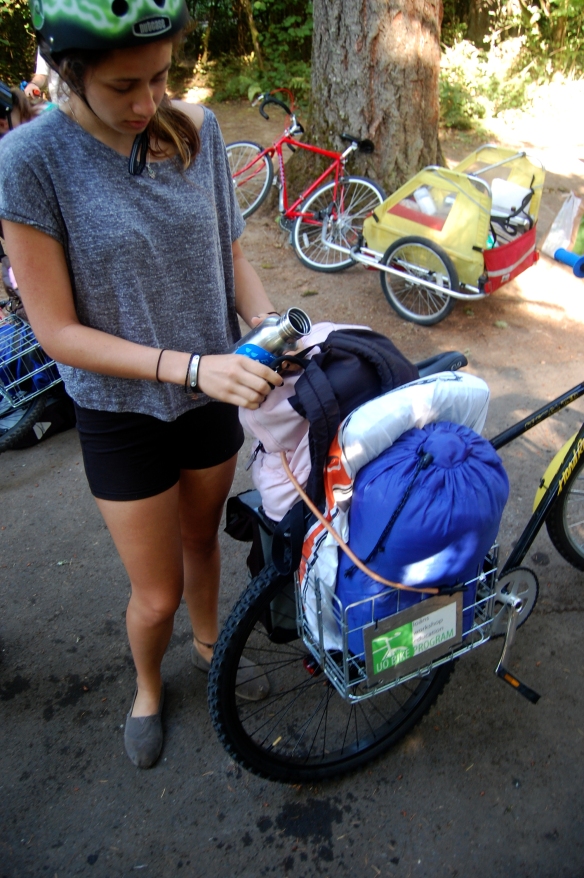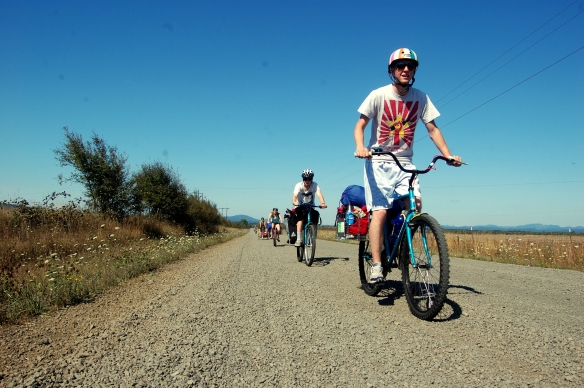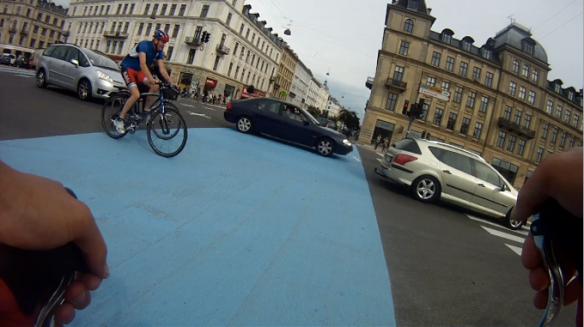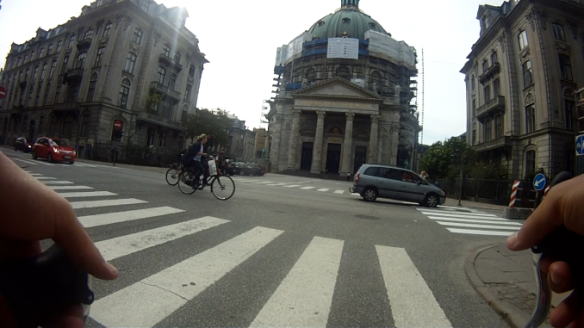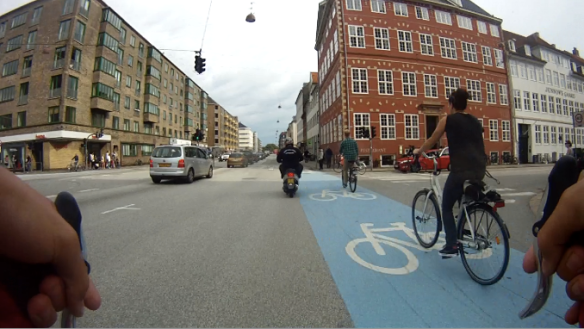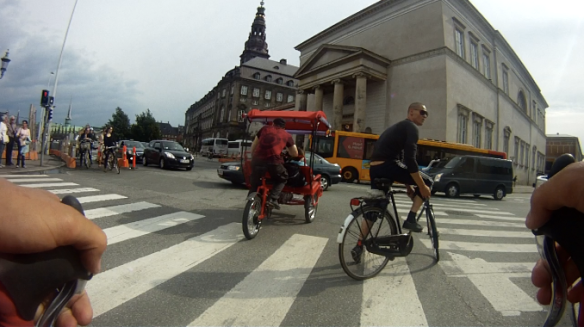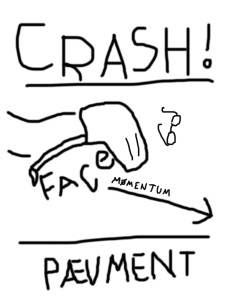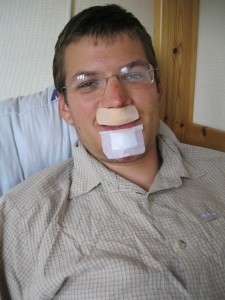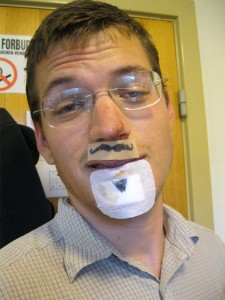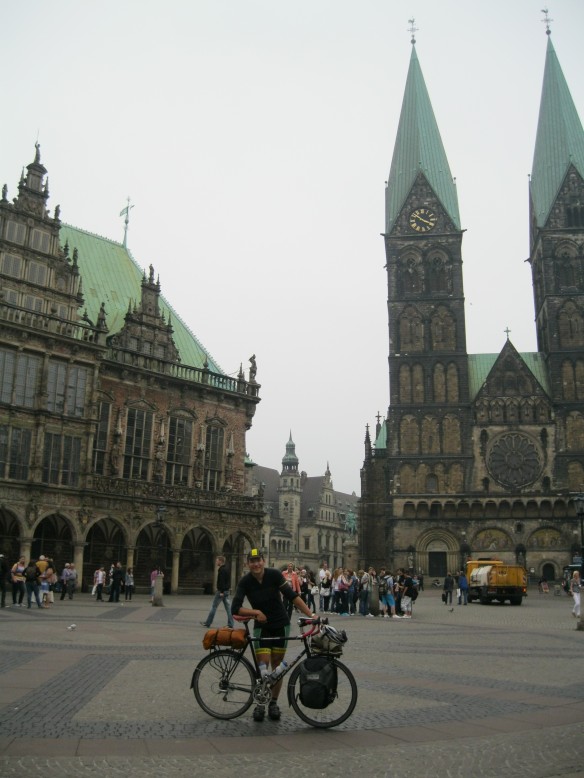This post is about my commuter bike, which is also the first real bicycle that I owned as an adult. I’ve found that the first real bicycle one owns as an adult tends to be formative; it’s the first bike you get that actually fits your body, that has features selected by you rather than by Santa, that you personally wonder about accessorizing. That bike, which one also tends to ride for adult purposes (going to work or on errands, going on longer rides for exercise) is the one that gains an air of legitimacy in your life as a real vehicle. It’s also the bicycle that a lot of Americans never get around to buying. Never owning a bicycle (that fits you, that you picked out) as an adult means that bicycles never prove their legitimacy to you. I am convinced that if most Americans simply tried riding bicycles that fit them, they would “get it.”
Again, this post is about my Redline 925, my first real adult bicycle. I bought it on craigslist when I returned to Eugene and UO after my year in AmeriCorps (07-08). I knew nothing about bikes at the time. I called up two bicycle-geek friends and made them not only pour over the CL ads with me, but also come out with me to look at the bicycle (also, Peter had a Subaru, and I had no vehicle whatsoever). My geek friends kicked the tires on this bike, criticized the guy selling it with words I had never heard like “trued,” and got the price down for me.
The 925 is a single speed commuter (9-2-5, get it? GET IT!?) bike with a flip-flop rear hub, meaning you can choose to make it a fixed gear with just a little bit of work. The frame is essentially road-bike shaped. Instead of the original mustache handlebars the guy had added some Cannondale drop bars, which made the bike feel fast and race-inclined. I liked that. I zipped all around Eugene with the glee that comes with the first adult bicycle.
Atop of my first adult bicycle, I started to notice all those little things about the transportation system that all cyclists notice; the potholes, the spotty bike-way network, the death-cheating situations, the fear, the insults (I’ll never forget my first major car-bike altercation; a guy almost hit me as he turned left, and hollered back “get a car, faggot!“). All of a sudden, as someone who relied on the bike for my personal freedom in the city (well, in Eugene), I cared about this stuff. In a major way, my first adult bicycle made me care about this stuff. Before I knew it I was on the city’s Bicycle and Pedestrian Advisory Committee, learning firsthand how the city and community were trying to deal with these issues. I took a bicycle maintenance class at the UO Bike Program, and soon afterwards took an opportunity to become coordinator of that program. I had also acquired my second adult bicycle, a yellow entry level Fuji road bike, and had started riding and racing with the UO Cycling Team. About a year and a half after letting my first adult bicycle, the Redline 925, into my life, everything I did revolved around bikes and bike advocacy. I think the Redline was the start of all of it.
Last fall, I wanted to race Cyclocross. Cyclocross is a combination of the best parts of mountain biking (interesting courses, dirt, more eclectic characters) and road biking (fast road bicycles, tight clothes, bright colors) with mercifully short races, obstacles that require you to get off and carry your bike, and a beer swillin’, bring-your-dog-to-the-race kind of attitude. Unfortunately, cyclocross bikes have some technical differences from normal road bikes, meaning I couldn’t use my Fuji. I was facing the prospect of having to get a new bike. Then I hit on a solution: I could use the Redline 925. It had room for the big tires needed to make cyclocross work. Since it was singlespeed, there wasn’t much that could break. As long as I found the correct gear ratio (how big the single gear is), I would b able to ride the whole course with ease. Here’s the redline set up for cyclocross, though still with my commuting bell on it (which I would ring liberally during races):
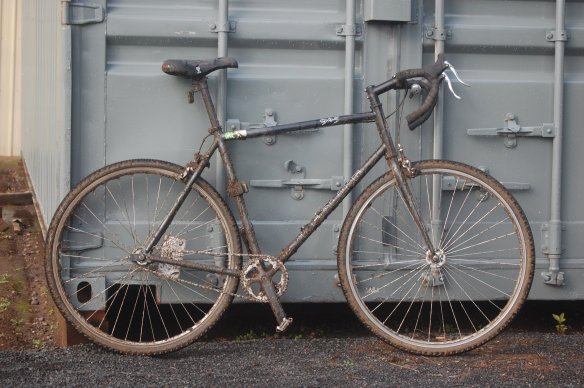 When I did finally get the gear right, I had a great time in those races. I mostly raced with the beginner category, so I had a chance to be competitive. I even came in first at one race:
When I did finally get the gear right, I had a great time in those races. I mostly raced with the beginner category, so I had a chance to be competitive. I even came in first at one race:
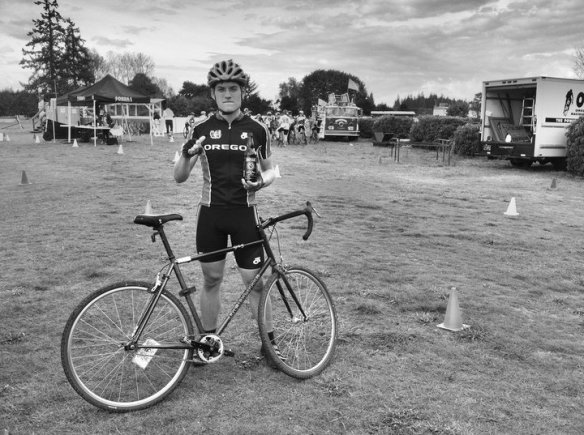 I won a beer. Go Ducks. Photo by Al.
I won a beer. Go Ducks. Photo by Al.
The Redline, made to ride around town rather than on the trail, performed pretty darn well for cyclocross. That leads into my overall message here, which is that one thing I love about bicycles is how versatile they are; even one single bicycle can be made to suit a very wide variety of needs with minor modification. When I needed the Redline to be a cyclocross racing bike, I just took off the fenders, put on some nobby tires, and went for it. Sure, purists shamed me for having road-style caliper brakes that lack the “mud-clearance” of cyclocross-standard cantilevers, but hey, being able to make my commuter do double duty instead of shelling out $900+ for an entry level ‘cross bike is a pretty damn fine deal. After the ‘cross season, the Redline went back to commuter duty, with a grocery rack and fenders.
While I was on my Northern European bicycle tour earlier this summer, I thought a lot about the kinds of bikes Europeans ride around their cities, and the features those bikes have. Really, in my mind, I was continuously re-accessorizing the Redline. By the time I returned I was absolutely rearin’ to set it up as the ideal city bike. So… from cyclocross bike to Dutch city bike in ten months… I bring you my new and improved first adult bicycle!
Here, again, is before:
 And, drumroll… AFTER!
And, drumroll… AFTER!
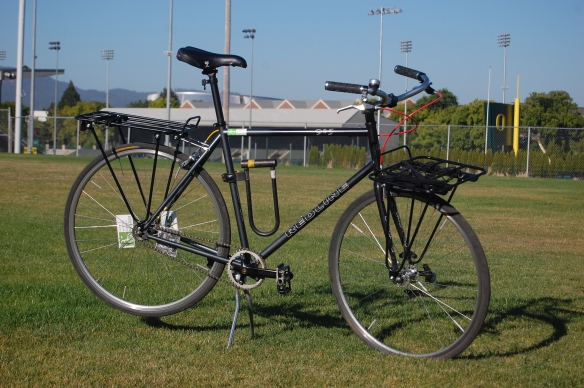 It’s summertime, so I haven’t put the fenders back on, but I’m sure you can excuse that in recognition of all the extraordinarily practical features this bike now offers! Starting with sexiest-first, we have the Pletscher Double Kickstand:
It’s summertime, so I haven’t put the fenders back on, but I’m sure you can excuse that in recognition of all the extraordinarily practical features this bike now offers! Starting with sexiest-first, we have the Pletscher Double Kickstand:
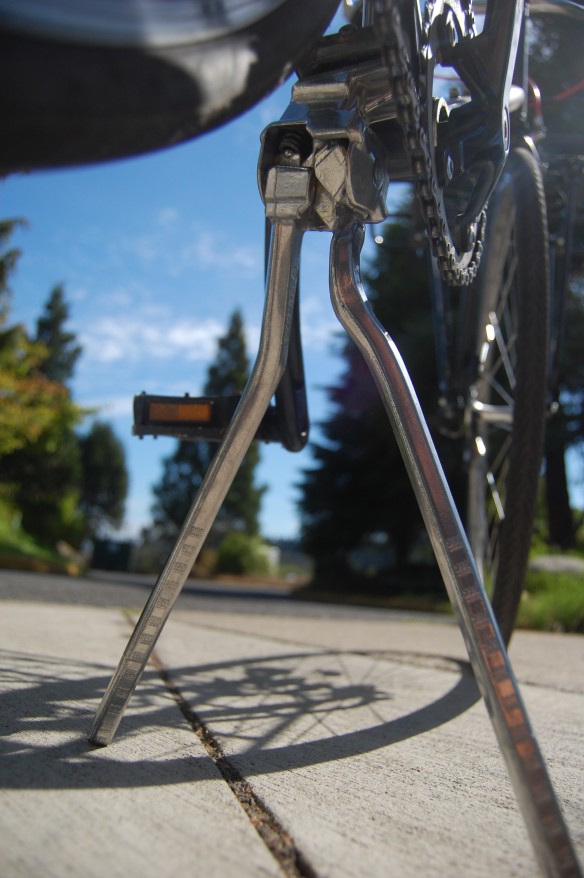 It has new handlebars (Nitto Allrounders) that give me an upright riding position (but not too upright, purists, don’t you worry), finally allowing me to take babysteps away from the craven, hunchbacked crouch of the road racer:
It has new handlebars (Nitto Allrounders) that give me an upright riding position (but not too upright, purists, don’t you worry), finally allowing me to take babysteps away from the craven, hunchbacked crouch of the road racer:
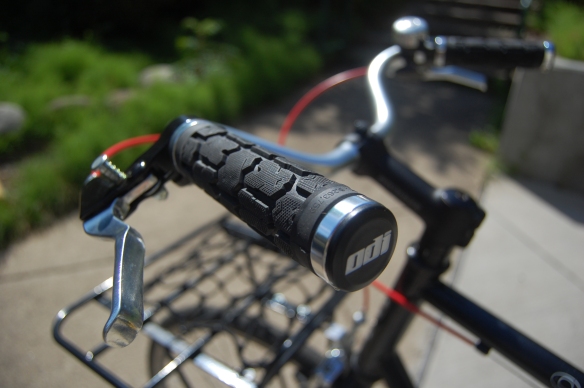 It has a new magnetic generator light in the front. These are especially popular in Copenhagen. They require no batteries, and they are difficult to steal. I use it mostly as a backup light, but it’s nice to know that if I forget my removable lights I am still legal and somewhat safe.
It has a new magnetic generator light in the front. These are especially popular in Copenhagen. They require no batteries, and they are difficult to steal. I use it mostly as a backup light, but it’s nice to know that if I forget my removable lights I am still legal and somewhat safe.
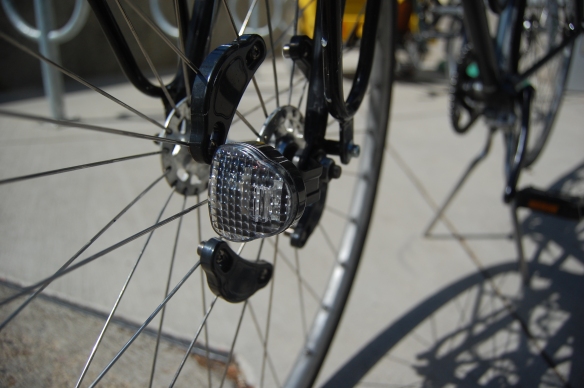 And of course there are the racks from Gamoh:
And of course there are the racks from Gamoh:
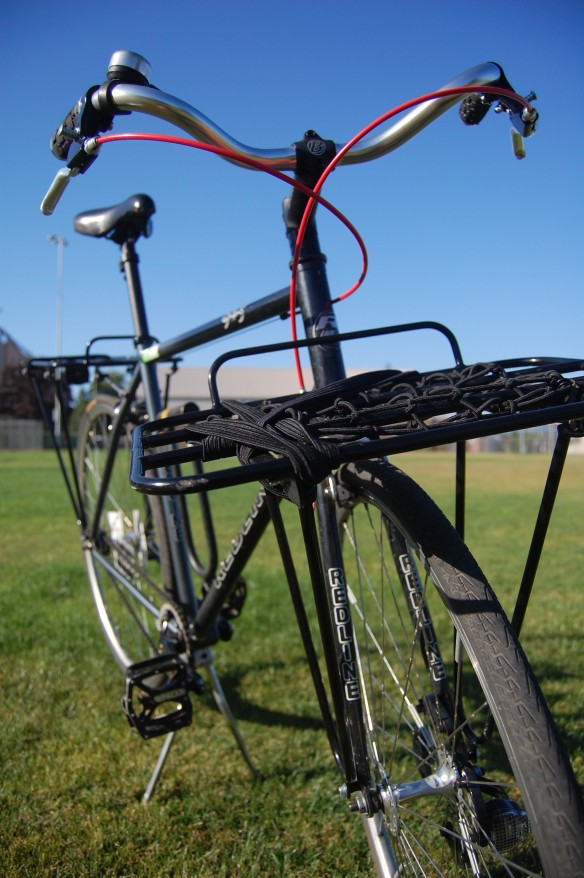 These racks are pretty serious about hauling things. In full recognition of the arguable pretentiousness of hauling things by bike, I am compelled to share with you some of the recent loads this beast has hauled.
These racks are pretty serious about hauling things. In full recognition of the arguable pretentiousness of hauling things by bike, I am compelled to share with you some of the recent loads this beast has hauled.
There was our new vacuum, a craigslist buy:
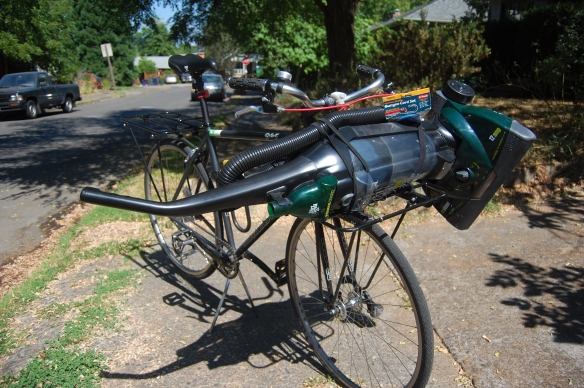 A whole load of group camping gear for the Pedal Project overnight trip, with some help from my Bike Friday trailer (bought that at a garage sale a while back for $20; Bike Friday sells them for the rather unbelievable price of $200-it’s just a rubbermaid container on a simple frame, though the hitch is pretty ingenious):
A whole load of group camping gear for the Pedal Project overnight trip, with some help from my Bike Friday trailer (bought that at a garage sale a while back for $20; Bike Friday sells them for the rather unbelievable price of $200-it’s just a rubbermaid container on a simple frame, though the hitch is pretty ingenious):
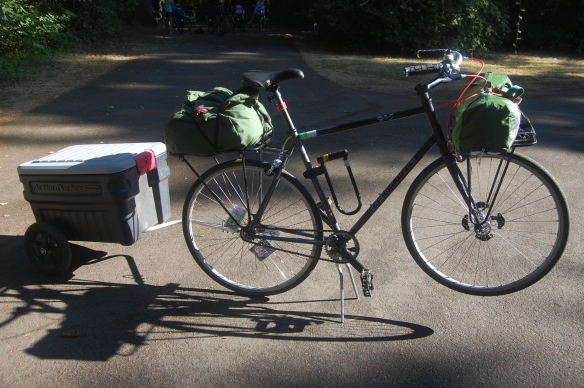 Finally, I hauled a huge load of unneeded things to the Goodwill on Franklin the other day; the box on the back really tested the limits of what the rear rack can carry, but I made it there with no mishaps. (w/ disembodied hand, below).
Finally, I hauled a huge load of unneeded things to the Goodwill on Franklin the other day; the box on the back really tested the limits of what the rear rack can carry, but I made it there with no mishaps. (w/ disembodied hand, below).
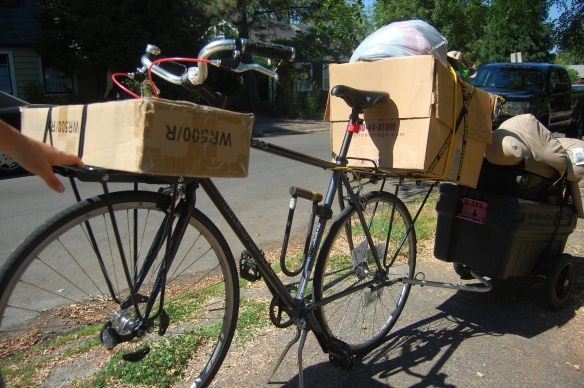 The racks are great. Gamoh also sells them with an extra rail wrapped around, to make a bit of a basket, and with wood panels between the bottom rails. These ones, the “porteur” style, are about $40-$50 cheaper than the equivalent CETMA. When I want to get a few groceries, I put them in a bag and bungie the bag down to the front rack. No problems yet.
The racks are great. Gamoh also sells them with an extra rail wrapped around, to make a bit of a basket, and with wood panels between the bottom rails. These ones, the “porteur” style, are about $40-$50 cheaper than the equivalent CETMA. When I want to get a few groceries, I put them in a bag and bungie the bag down to the front rack. No problems yet.
Of couse, my bike is missing some essentially Euro features. I may still add a chain guard. I don’t really have a good way to attach the rear wheel lock, and it really isn’t very useful in bike-theft heavy Eugene anyway (I do think rear wheel locks are cool, though). So far, rather than switch to something springy and leather, I’m sticking with my WTB saddle that has served me well though all the phases of the Redline.
Part of my journey from knowing nothing about bikes to being overly obsessed with them has been about trying out the different contexts that involve the bicycle. From basic commuting to recreational riding to racing, to advocacy and back to commuting, this Redline has been the physical manifestation of my own progression through the world of bicycles. I have no idea what urge will seize me next (mmm… internal geaaaarrrrrrring), but I have confidence that my first adult bicycle, the Redline 925, is up to it. Your bike probably is too.
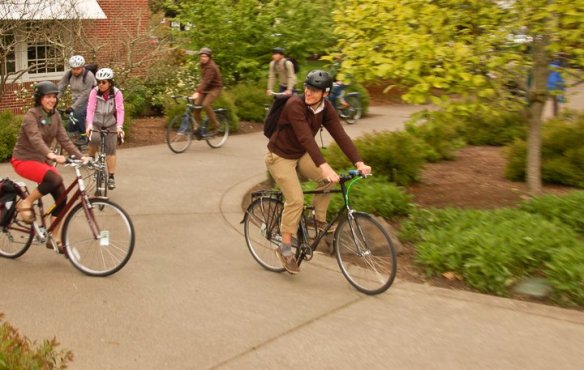 Photo by Fred Sproat, from Andy Clarke‘s visit to campus to award us the Silver Level Bike Friendly University award.
Photo by Fred Sproat, from Andy Clarke‘s visit to campus to award us the Silver Level Bike Friendly University award.

